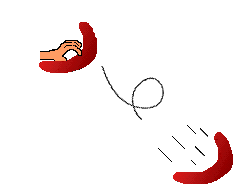Flying
Wing
SUBJECT:
Aeronautics
TOPIC: Gliding flight
DESCRIPTION: An acrobatic flying wing is constructed from plastic foam
trays obtainable from a supermarket.
CONTRIBUTED BY: Norm Poff (adapted from a design by Paul Mcilrath.)
EDITED BY: Roger Storm, NASA Glenn Research Center
MATERIALS:
Plastic foam meat or pastry tray, about 10 inches long, from a supermarket
Sharp cutting knife and cutting surface
Emery board, sandpaper, or metal file
Cellophane tape
Dime
Marker pen
Scissors
PROCEDURE:
1. Cut out and
trace the Flying Wing pattern on the bottom of the foam tray.
CLICK HERE TO GO TO THE TEMPLATE Position
the pattern so that the shaded wing tips lay on one of the upturned edges
of the tray. When cut out, the wing tips will have a permanent upward bend.
 2.
With the emery board, sandpaper, or metal file, shape the upper surface of
the Flying Wing into an airfoil. Use the cross-section diagrams as a guide
for shaping. Take your time and try to keep both sides symmetrical. This part
is better done outdoors.
2.
With the emery board, sandpaper, or metal file, shape the upper surface of
the Flying Wing into an airfoil. Use the cross-section diagrams as a guide
for shaping. Take your time and try to keep both sides symmetrical. This part
is better done outdoors.
3. Tape the dime to the underside of the wing so that it is positioned
just forward of the center mark. It will probably be necessary to adjust the
position of the dime a few times to get the best position for flight. The
Flying Wing is ready for test flights.
BALANCING AND FLYING THE FLYING WING:
 Go
to an open area and hold the Flying Wing in your hand as shown in the diagram.
Toss the wing gently straight forward. Observe the flight of the Flying Wing.
Go
to an open area and hold the Flying Wing in your hand as shown in the diagram.
Toss the wing gently straight forward. Observe the flight of the Flying Wing.
PROBLEMS AND CURES
|
FLIGHT PATH
|
CORRECTION
|
|
FLIES STRAIGHT GLIDES SMOOTHLY
|
DON'T MESS WITH IT!
|
|
BANKS TO THE RIGHT
|
SLIGHTLY FLATTEN THE RIGHT WING TIP BEND
|
|
BANKS TO THE LEFT
|
SLIGHTLY FLATTENT THE LEFT WING TIP BEND
|
|
STALLS
|
MOVE DIME SLIGHTLY FORWARD
|
|
DIVES TO THE FLOOR
|
MOVE DIME SLIGHTLY BACKWARD
|
DISCUSSION:
The shape of the Flying
Wing is adapted from the zanonia seed which is found in southeast Asia. When
mature, the seed drops from the vine and glides to a new location to reproduce
itself.
To provide stability in
flight, the wing tips of the Flying Wing are upturned. These tips appear to
serve as drag rudders that keep the trailing edge of the wing trailing in
flight. The presence of the upturned wing tips also directs air flowing over
the wing tips upward. This results in a downward thrust that attempts to pitch
the trailing edge of the Flying Wing downward around its center of gravity.
The dime is taped to the underside of the leading edge of the Flying Wing
to increase its weight there and balance the pitching tendency during gentle,
gliding flight. At higher forward velocities, the downward thrust of the wing
tips is magnified, pitching the trailing edge down and the leading edge up.
The Flying Wing begins looping maneuvers and continues until drag slows it
and the Flying Wing gently glides to the ground.
Return to Aeronautics Activities
Return to Aerospace Activities Page
Objects that Lift
Forces on a Glider
Aerospace
Education Services Project
Oklahoma State University
